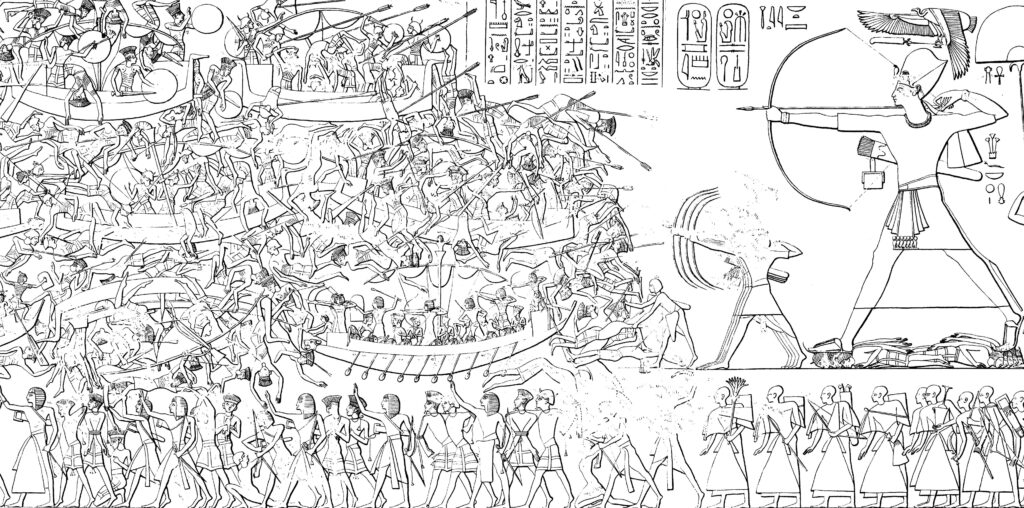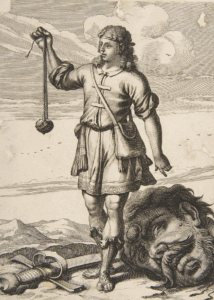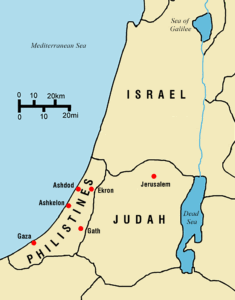By Dr. Don Bierle, FaithSearch President
Goliath was identified with the Philistines – all nine-and-one-half feet of him! His equally giant brother, Lahmi, and other family giants Eshbi-Benob, Sippai, Saph, and an un-named giant with polydactylism (twelve fingers and twelve toes) from the city of Gath, are all identified in 2 Samuel 21:16-22. They were feared Philistine warriors from whom the Israel army fled and “were greatly afraid” (1 Samuel 17:24). [For the question of the reality of biblical giants, see my article on “Giants” in Happ-O-getics 1:6.]
When you think of the formidable Philistines, you must also associate them with the Israeli names of Samson and David. They were also quite “formidable.” In this article, I will review the history of the Philistines and their encounters with Israel. It is interesting that the enemies of Israel seem to gather along the eastern coastline of the Mediterranean (see the map). That is where the Philistine empire was located, including present day Gaza. They were a people of war.
Which Philistines?
There are no living people who are ethnically Philistine: the Philistines became an extinct ancient people already in the fifth century BC. Their history, while complicated, has recently gained new clarity. The following will provide an insightful summary.
- The first reference to the Philistines is in the Table of the Nations in the lineage of Ham (Genesis 10). In the period of 2000-1800 BC, we read in the Bible that Abraham and his son Isaac were their neighbors in southwestern Palestine (Genesis 21:22-34; 26:1, 18). These Philistines were agriculturalists and not warlike. Their ancestor was Casluhim (10:14) who was born in Egypt and whose descendants settled in Gerar and Bethsheba in southwestern Palestine. The coastal Mediterranean strip called “Philistia,” Gaza today, is from an Egyptian word.
- The most familiar Philistines, however, were hated enemies of Israel who appear in the Bible record after the Jewish exodus from Egypt in the period 1250 BC and later (Judges 10:6-8; 13:1). They were warlike, pagan, and often dominated militarily during the time of Samson (Judges 15) and David (2 Samuel 21:15-22). According to the prophet Amos (9:7) in the eighth century BC; Jeremiah (47:4) in the seventh century BC; and in Deuteronomy 2:23; these Philistines came from Caphtor, usually identified with the island of “Crete” in the Aegean Sea.
External Evidence
The archaeological evidence points to Crete as these later Philistines’ original homeland.
- Excavations of pottery and other artifacts in Philistia parallel Aegean artifacts.
- A 2019 DNA study on over 150 graves in Ashkelon (a city in Philistia) revealed that these later Philistines had a significant amount of southeast European DNA (fitting the Aegean origin) which was not present in the earlier Philistines.
- A drawing on the temple wall at Medinet Habu in Egypt shows a sea battle between the Egyptians and island tribes in the twelfth century B.C. After the defeat of the “islanders,” the document states that these “islanders” then settled on the southern coast of Canaan which is the land of Philistia.

- A seventh-century inscription from the Philistine city of Ekron names their king as Ikausu, which means “Achaean” or “Greek.” Likewise, the name Ikausu (Ashish) also appears in 1 Samuel 21:10 as the king of the city of Gath. Even after centuries these Philistines apparently remembered their Aegean origin.
- There was a massive volcanic explosion in the middle of the Aegean Sea around the 1600 BC. This had a profound negative effect on the ancient Aegeans, including the Minoan civilization on Crete. This may have contributed to a cultural upheaval called the Late Bronze Age Collapse (1,200 BC) and the Cretans migration to the eastern Mediterranean.
It seems then, that these Philistines may have been a part of the “sea peoples” of the Aegean who migrated and occupied the Mediterranean coast from Joppa to south of Gaza, at about the time of Israel’s exodus from Egypt. (These are not the same Philistines whom Abraham knew.) This is also consistent with the “alternate route” on which God took the Israelites when they left Egypt:
When Pharaoh let the people go, God did not lead them by way of the land of the Philistines, although that was near; for God said, “Lest the people change their minds when they see war, and they return to Egypt” (Exodus 13:17).
Even after Canaan had been successfully invaded by the Israelites, God spoke to an aged Joshua about the peoples who had yet to be conquered:
Now Joshua was old and advanced in years, and the Lord said to him, “You are old and advanced in years, and there remains yet very much land to possess. This is the land that yet remains: all the regions of the Philistines… there are five rulers of the Philistines, those of Gaza, Ashdod, Ashkelon, Gath, and Ekron…in the south… (Joshua 13:1-3).
The Philistines were strong and technologically advanced. They evidently held off the Israelites for a long time since they are mentioned throughout the Judges, mentioned often in 1 and 2 Samuel, and in the writings of several prophets.
Afterglow
What are we to make of this history – of both the Philistines and the Israelites?
Who are the “formidable dudes” in this article: the Philistines? Israel? Neither. The despicable, idol-worshipping but physically strong Philistines were gone forever within one hundred years (Ezekiel 25:16). God’s chosen people Israel still wander spiritually, not having been fulfilled by their rejection of the Messiah and Savior Jesus whom God sent for their redemption (Luke 2:10-11). Only God emerges as “formidable” (awe-inspiring in excellence)!
In the flesh, God’s purpose is clear:
He has shown you, O man, what is good; and what does the Lord require of you but to do justly, to love mercy, and to walk humbly with your God? (Micah 6:8, NKJ).
In the Spirit, God’s purpose is also clearly stated:
For this is the will of My Father, that everyone who beholds the Son, and believes in Him, may have eternal life; and I Myself will raise him up on the last day (John 6:40).
Now that’s fulfillment!
Sources: Feldman, M. et al., “Ancient DNA sheds light on the genetic origins of early Iron Age Philistines,” Science Advances 5:eaax0061, 2019. Daniel M. Master, “Piece by Piece: Exploring the Origins of the Philistines.” Biblical Archaeology Review, Spring 2022.





